Clip shows recycle previous footage to create new episodes with minimal production costs, often serving as a nostalgic trip for audiences. Bottle episodes focus on limited settings and characters, emphasizing dialogue and character development to deliver impactful storytelling within budget constraints. Both formats provide creative ways to balance cost efficiency while maintaining viewer engagement in television entertainment.
Table of Comparison
| Aspect | Clip Show | Bottle Episode |
|---|---|---|
| Definition | Episode featuring reused scenes from previous episodes. | Episode set in a single location with limited cast and new content. |
| Purpose | Cost-saving by recycling footage. | Budget-friendly storytelling focused on character development. |
| Storytelling | Relies on flashbacks and narration. | Emphasizes dialogue and plot within confined space. |
| Viewer Appeal | Often seen as filler, less engaging. | Critically praised for creativity and depth. |
| Examples | "The Simpsons" clip episodes. | "Breaking Bad" episode "Fly". |
Understanding Clip Shows and Bottle Episodes
Clip shows recycle previous scenes to reduce production costs while providing nostalgic value, often highlighting key moments in a series. Bottle episodes confine the narrative to a limited setting and few characters, intensifying character development and dialogue-driven storytelling. Both formats serve strategic purposes: clip shows offer cost-effective retrospectives, whereas bottle episodes maximize emotional impact with constrained resources.
Key Differences Between Clip Shows and Bottle Episodes
Clip shows primarily reuse previous footage to recap or highlight past events, conserving production costs and time, while bottle episodes are original stories confined to a single setting, often relying heavily on character interactions and dialogue. Clip shows often serve as filler episodes within a season, whereas bottle episodes aim to deepen character development and plot within budget constraints. The key difference lies in footage reuse versus new content creation within limited sets.
The Evolution of Clip Shows in Television
Clip shows evolved from cost-saving filler episodes to innovative storytelling tools that enhanced character development and plot depth by revisiting iconic moments. Bottle episodes, confined to limited sets and minimal cast, emphasized intense character interaction and dialogue, contrasting with clip shows' reliance on archival footage. The shift toward integrating flashbacks creatively marks a significant evolution in television's narrative techniques, blending nostalgia with fresh perspectives.
Why Do TV Series Use Bottle Episodes?
TV series use bottle episodes to reduce production costs by limiting cast, sets, and special effects, often focusing on character development and dialogue within a single location. These episodes provide writers an opportunity to explore deeper narratives and tension among characters, enhancing the overall story arc without the need for expansive resources. By isolating the story, bottle episodes heighten emotional intensity and engage audiences with intimate, character-driven plots.
Narrative Impact: Clip Shows vs. Bottle Episodes
Clip shows recycle existing footage to recap or highlight key moments, reducing production costs but often resulting in limited narrative progression and diminished viewer engagement. Bottle episodes use a single setting and a small cast to intensify character development and dialogue, creating a deeper emotional impact and advancing the storyline through focused interaction. The narrative impact of bottle episodes typically exceeds that of clip shows by fostering originality and sustained tension within constrained environments.
Budgetary Motivations for Clip Shows and Bottle Episodes
Clip shows minimize production costs by recycling existing footage, reducing the need for new sets, actors, and special effects. Bottle episodes are designed with limited locations and cast, containing expenses while delivering original content. Both formats strategically manage budgets during tight financial periods in television production.
Memorable Clip Shows in TV History
Memorable clip shows in TV history, such as *Friends*' "The One with the Monkey," creatively leverage past episodes to evoke nostalgia while advancing the storyline. These episodes highlight iconic moments, offering viewers a retrospective experience without the high production costs of new content. Unlike bottle episodes that focus on limited settings and new dialogue, clip shows rely heavily on curated highlights to celebrate a show's legacy.
Iconic Bottle Episodes Across Genres
Iconic bottle episodes, such as "The One Where No One's Ready" from Friends and "Fly" from Breaking Bad, showcase tight storytelling within confined settings, emphasizing character development and dialogue. These episodes contrast with clip shows by offering original content that deepens narrative impact without relying on recycled footage. Across genres, bottle episodes stand out for their budget efficiency and ability to deliver high emotional stakes in limited spaces.
Audience Reception and Critique
Clip shows often receive mixed audience reception due to their reliance on recycled footage, which can be perceived as a cost-saving shortcut that disrupts narrative flow. Bottle episodes, characterized by limited settings and character interactions, tend to garner critical acclaim for their focus on dialogue and character development, intensifying viewer engagement and emotional investment. Critics highlight that while clip shows may alienate loyal fans seeking fresh content, bottle episodes are praised for creativity and depth despite budget constraints.
The Future of Clip Shows and Bottle Episodes
Clip shows and bottle episodes continue evolving as cost-effective storytelling methods in television, with streaming platforms driving innovative formats. Advances in technology enable seamless integration of past footage in clip shows, while bottle episodes increasingly rely on confined settings to deepen character development and thematic exploration. These trends suggest future content will blend nostalgia with fresh perspectives, enriching audience engagement and preserving production efficiency.
clip show vs bottle episode Infographic

 difterm.com
difterm.com